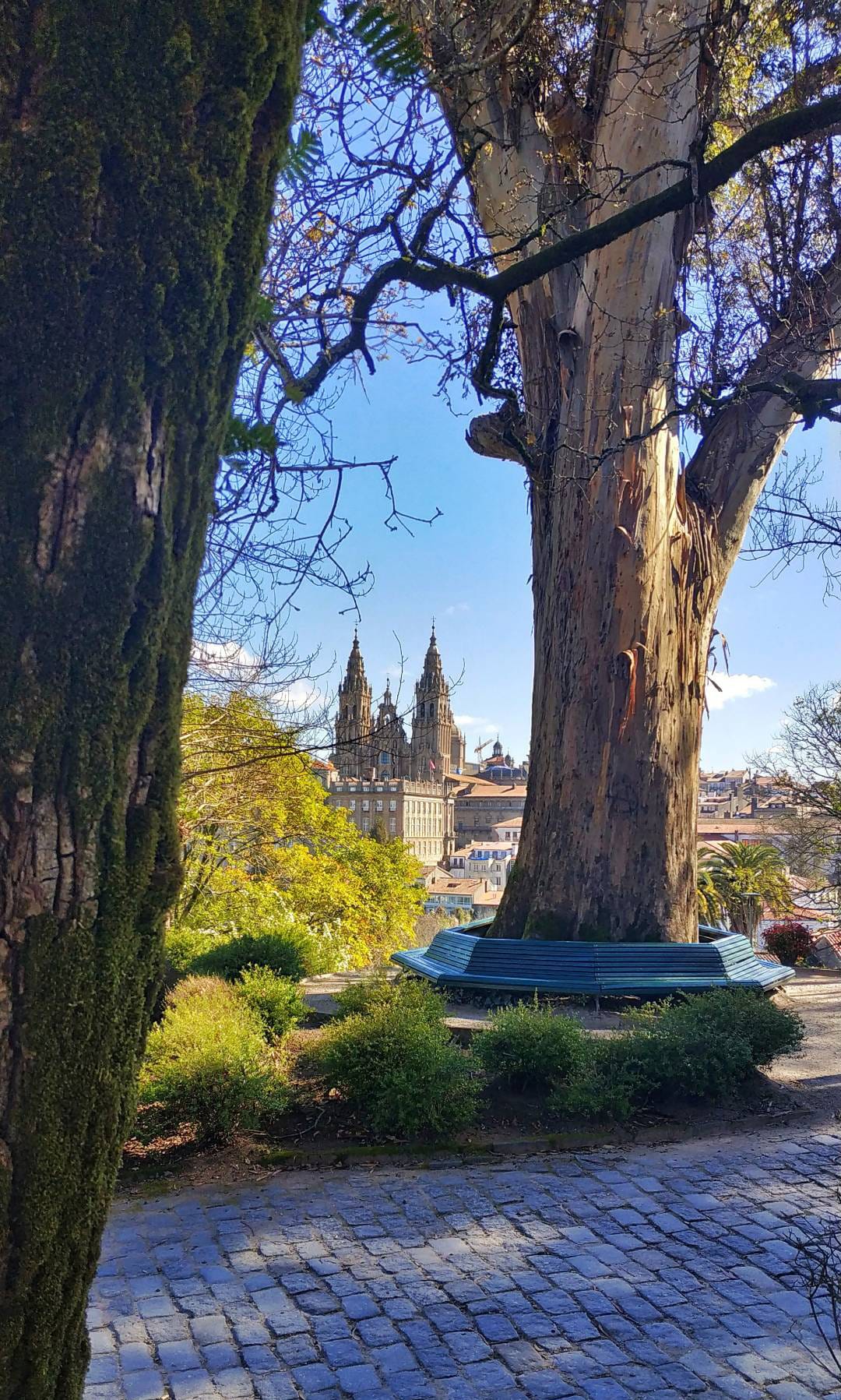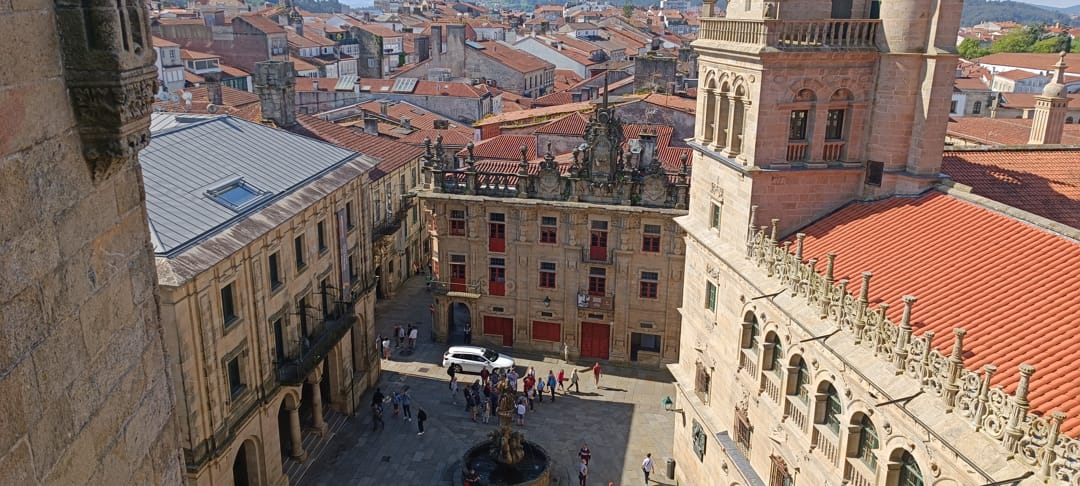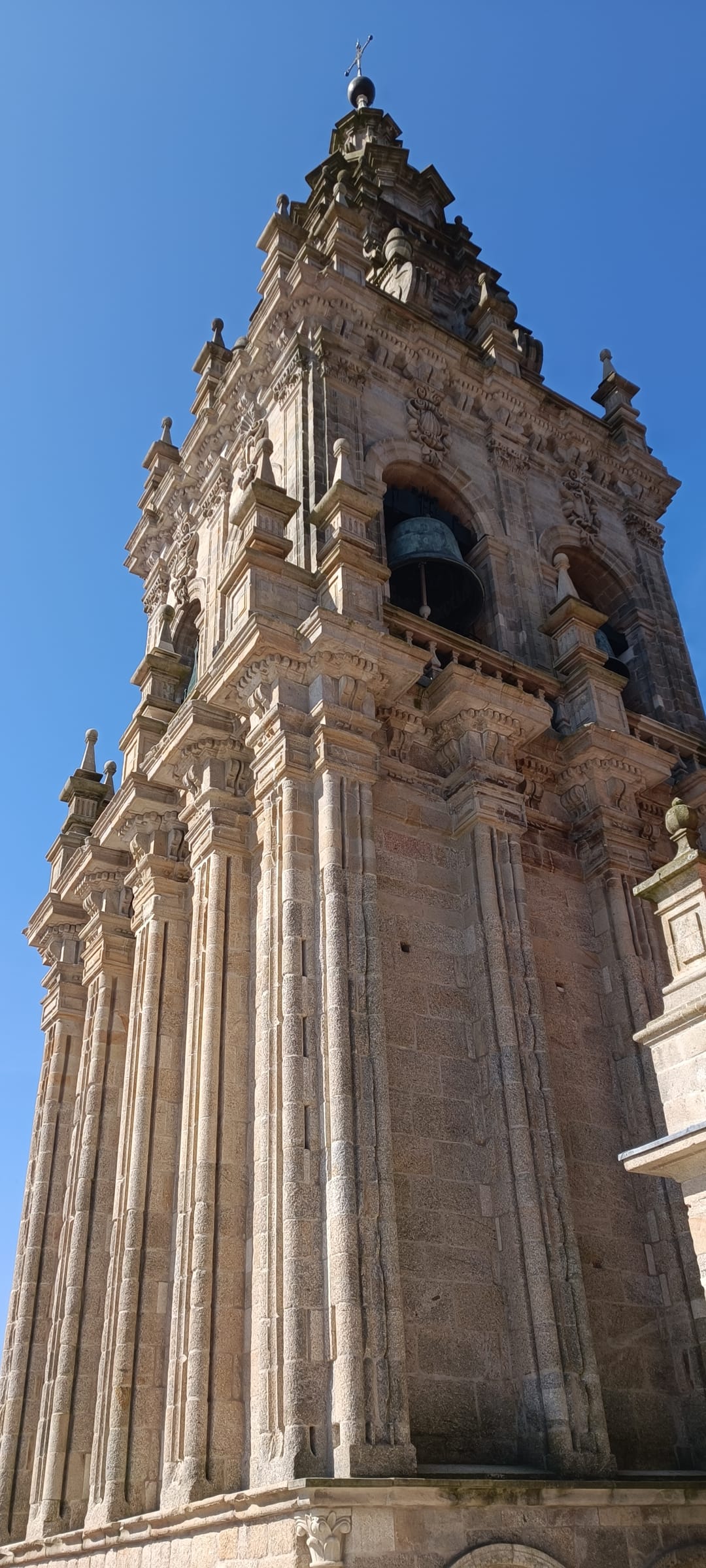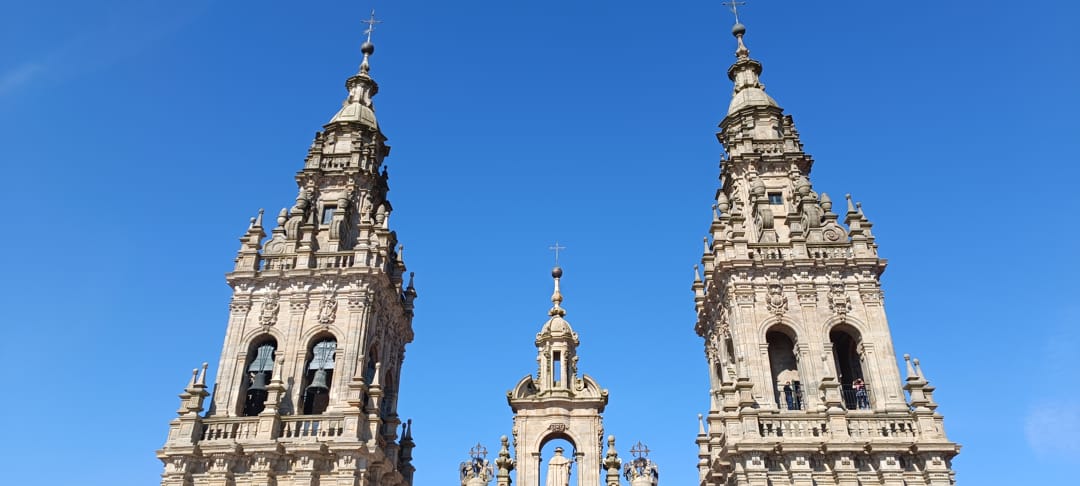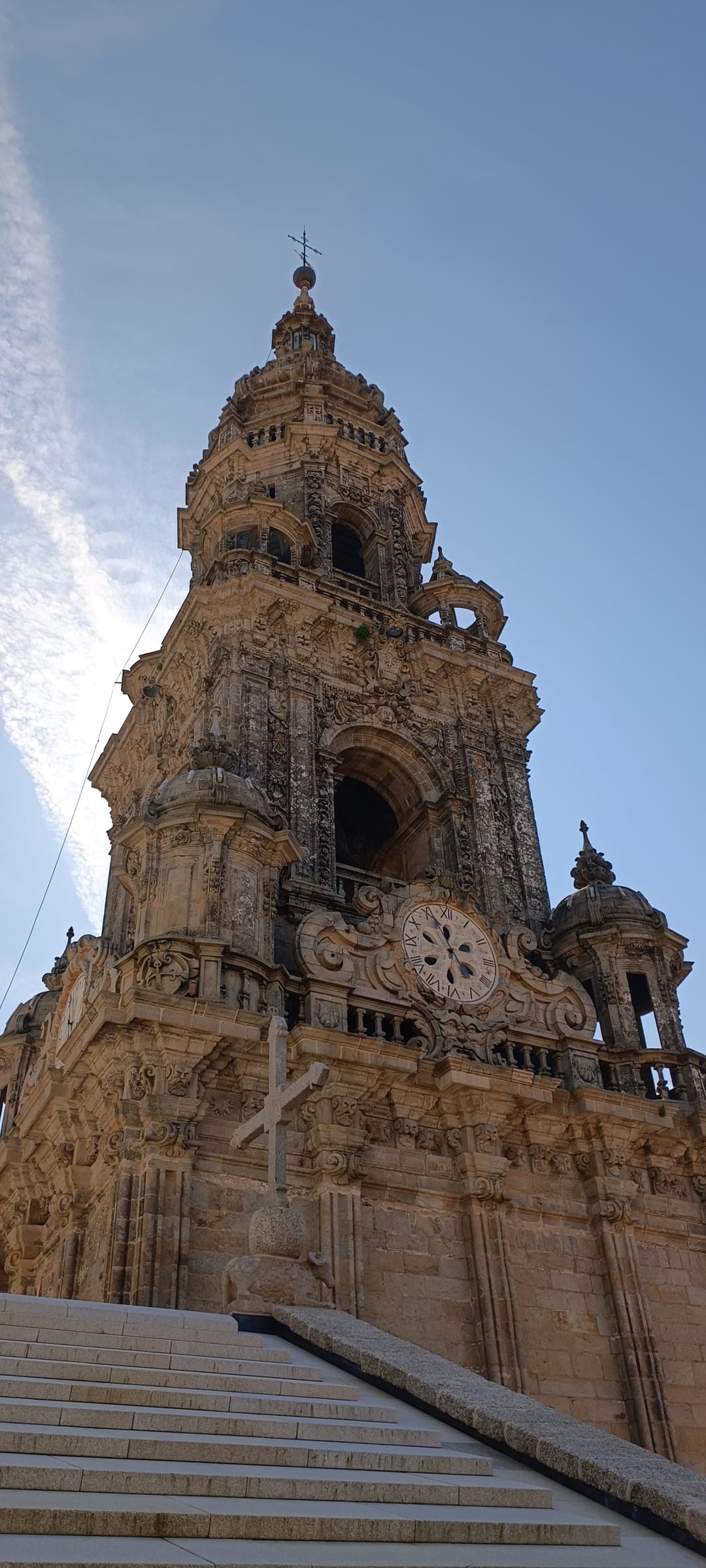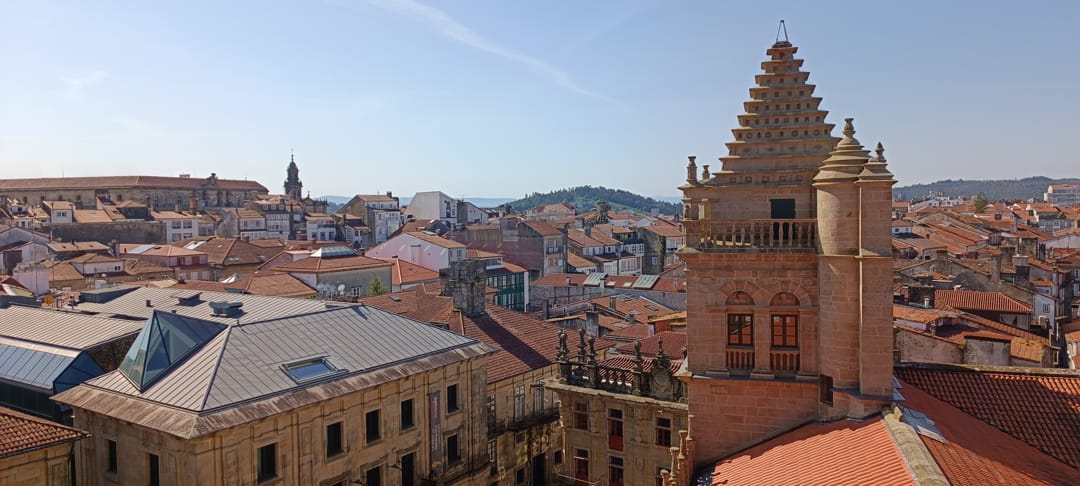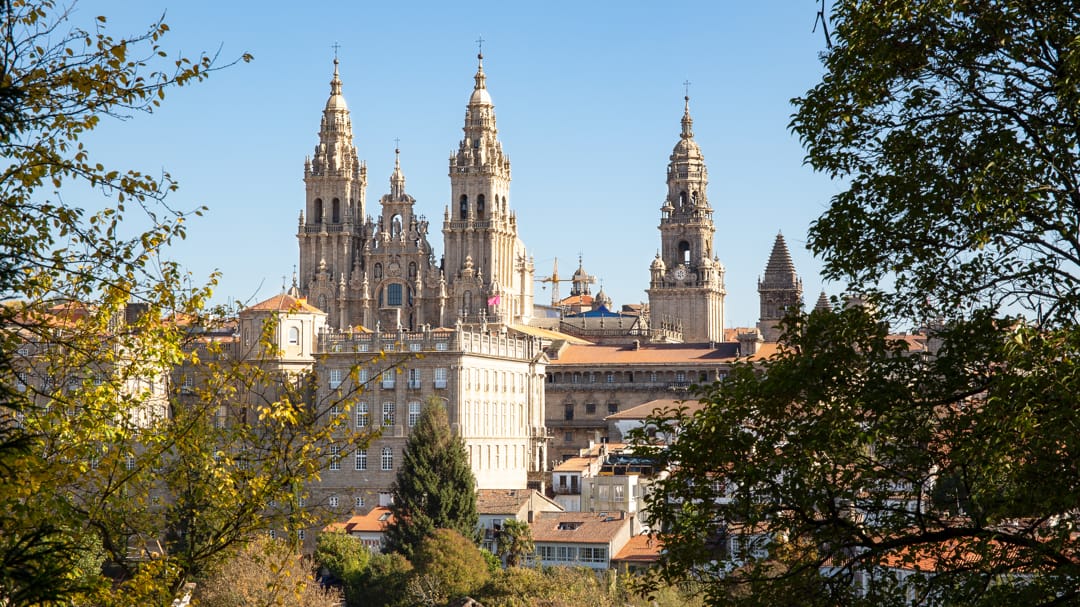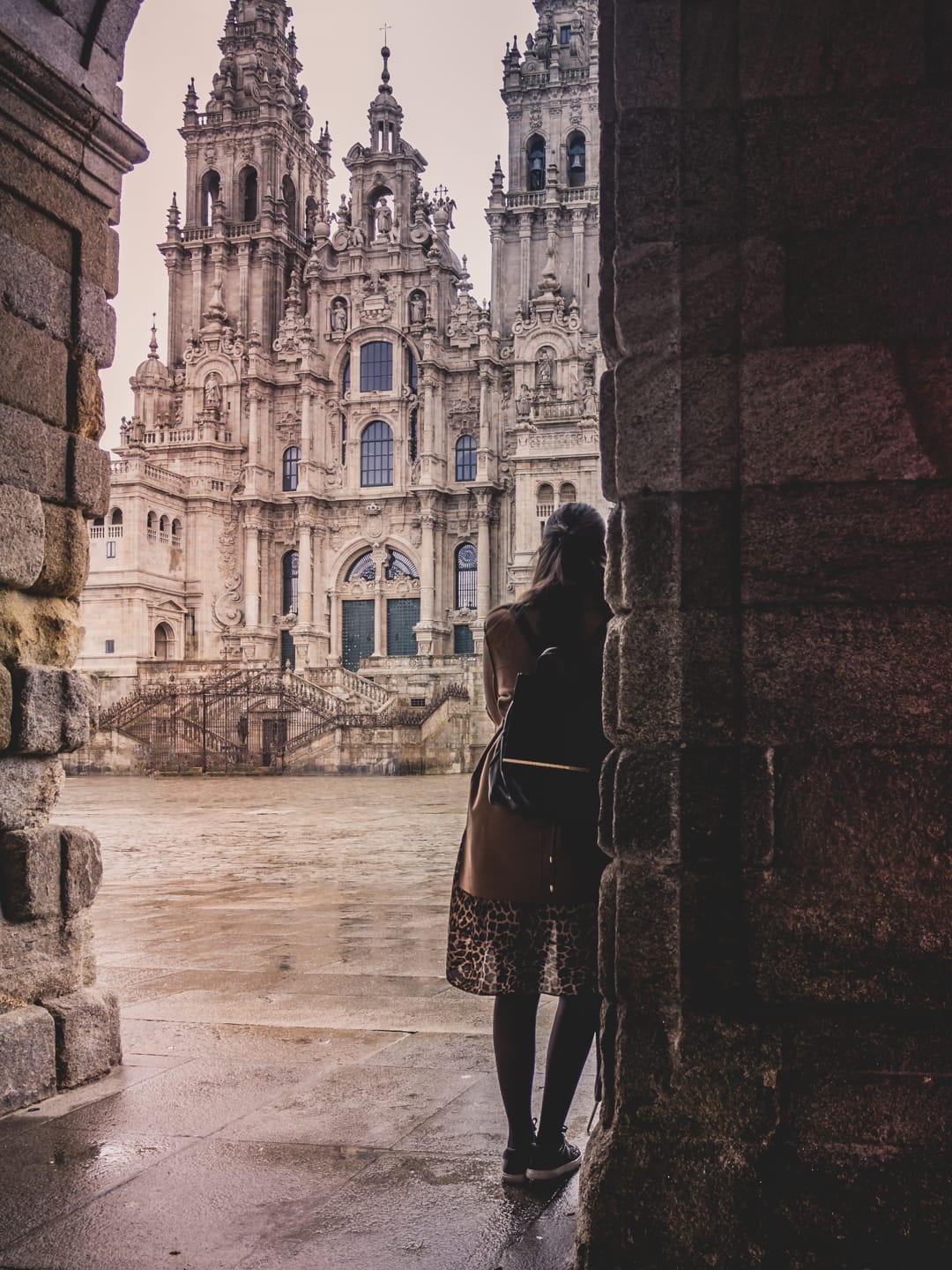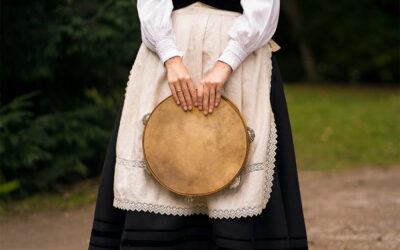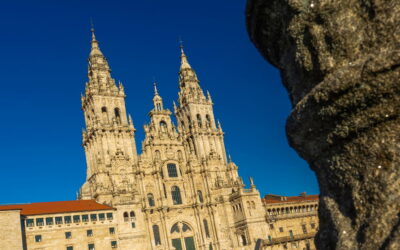visit
the cathedral
The cathedral of Santiago de Compostela attracts millions of people from all over the world every year. It is undoubtedly one of the most important tourist attractions in Europe.
History
inside
Altar
portico
botafumeiro
Cathedral of Santiago de Compostela
A millenary history
The Cathedral of Santiago de Compostela has its origin in a small Roman mausoleum from the 1st century. In this mausoleum the remains of St. James the Apostle were buried after his beheading in Palestine in 44 A.D. and his subsequent transfer by sea to the shores of the finis terrae, near the city of Santiago de Compostela.
For many centuries, a small local Christian community assiduously visited the subway chamber and the surrounding necropolis. However, very little is known about this community, which was probably decimated in the 8th century.
In the year 813, the miraculous discovery of the relics of the Apostle took place. A hermit found the relics under the undergrowth of Mount Libredon, after seeing celestial signs there. The bishop of Iria Flavia was informed of the discovery and the Asturian king Alfonso II ordered the construction of a stone and mud chapel next to the ancient mausoleum. In 834, this chapel received a royal Preceptum that made it an episcopal see and gave it power over the nearby territories. As devotion to Santiago spread, the first settlers and monastic groups of Benedictines established themselves around the chapel, laying the foundations for what would become the future city of Santiago de Compostela.
The first chapel soon became too small to accommodate the faithful, so between 872 and 899, King Alfonso III The Great ordered the construction of a larger temple. However, this second temple was destroyed in 997 by an attack of the Muslim leader Almanzor. Bishop San Pedro de Mezonzo was in charge of its reconstruction in 1003, in a pre-Romanesque style. This third temple was still standing when the boom in pilgrimages and the wealth generated by the devotion to Santiago allowed the construction of the present Romanesque cathedral to begin in 1075.. This cathedral, which is the fourth sacred building built over the ancient tomb of the Apostle, has survived to the present day.
The Leonese king Alfonso VI and the first archbishop of the city, Diego Gelmirez, played a fundamental role in the development of the cathedral, urban life and pilgrimages. During the 12th century, considered the most splendorous in the history of Santiago de Compostela, a great pilgrimage cathedral was designed following the Romanesque style that extended along the Camino de Santiago. The best builders of the Romanesque worked in the cathedral, and he highlighted especially the work of Maestro Mateo,, author of the last sections of the naves, the defensive towers on the west, the crypt, andabove all, the Portico of Glory,a sculptural ensemble, unparalleled in Europe, still presides over the west entrance of the cathedral to this day.
In 1211, the Cathedral of Santiago de Compostela was consecrated and already enjoyed special privileges. In 1181, Pope Alexander III granted plenary absolution to all those who visited the cathedral during a Jubilee Holy Year, as well as a valuable document certifying having traveled the Camino de Santiago and assuring the right of asylum in the city. This turned the cathedral into a destination of salvation and generated a great influence in the construction of roads, hospitals, shelters, markets and villages along the routes that pilgrims traveled to Santiago.
Over time, Gothic, Renaissance and Baroque elements were added to the original Romanesque structure of the cathedral. As the archbishopric and patrons provided funds, more chapels were built for worship and internal alterations were made, adding altarpieces, pulpits and sculptures. During the 14th century, the cathedral acquired the characteristics of a fortress, with the incorporation of defensive towers such as the current Clock Tower. With the Renaissance,propelled by the Archbishop Alfonso III de Fonseca, the final cloister,which replaced the Romanesque cloister and modified the entire south and southeast wing of the church. It was a time of internal reforms and addition of altarpieces, pulpits and sculptures, all in honor of the Apostle.
The major aesthetic transformation of the cathedral took place during the Baroque period, beginning in 1660. At that time, the main altar and the dome were remodeled, the organs were designed, the canvas of the Holy Door was traced, the Clock Tower was embellished and the peak of the baroque period was reached with the completion, in 1750, of the facade of the Obradoiro, the most iconic image of the cathedral.
The Baroque masters of the cathedral, such as Vega y Verdugo, Domingo de Andrade, and Fernando de Casas Novoa, were also responsible for the design of the monumental plazas surrounding the cathedral and many other adjacent buildings. The Baroque not only left its mark on the cathedral, but also extended to the squares, monasteries and noble houses, turning Compostela into an imaginative, scenographic and dramatic city that today is recognized as “the Baroque city par excellence of Spain”.
After two thousand years of history as a spiritual center and almost a thousand years since the construction of its current building, the Cathedral of Santiago de Compostela is presented as a heterogeneous set of spaces and aesthetic elements that tell the extraordinary history of the city. Throughout its existence, the cathedral has witnessed a wide variety of sacred and mundane events, from the coronation of the kings of Galicia in the Middle Ages to the quartering of French soldiers during the War of Independence. It has been the scene of concord and discord, exaltations and lynchings, political conspiracies and religious splendor, incendiary attacks and costly beautification campaigns, pomp and beneficence, donations and plundering, collection of perks and sponsorships, solemn offerings and, above all, incessant pilgrimages to the tomb of the Apostle.
Interior of the cathedral
The Cathedral of Santiago de Compostela is an impressive Romanesque temple with a Latin cross plan with three naves and a wide transept. The main nave is about 94 meters longwhile the transept is about 63 meters long,which makes it the largest Romanesque temple in the country.. The height of the halls varies between 20 and 32 meters.
The interior of the cathedral is covered by a barrel vault in the central nave and groin vaults in the lateral ones. The semicircular arches and the triforium give the naves an elegant and luminous appearance. The main facade has a large stained glass window that brings abundant light into the interior.
In the past, the center of the main nave housed a majestic stone choir by Master Mateo, but it was replaced by a Renaissance wooden choir in the 17th century and later dismantled. This allowed for a better view of the altar.
The chevet of the cathedral has an ambulatory that surrounds the main altar. This facilitates access to the radial chapels and the subway mausoleum that houses relics.
Over the centuries, many chapels were joined or reformed in the cathedral, reaching 16 chapels today. In addition, there is an apostolic crypt, a crypt in the Portico of Glory and a separate parish called the Corticella.
In the chapels, pilgrims met the saints of their devotion. Some of them present a combination of architectural styles, such as Romanesque, Gothic, Renaissance, Baroque and Neoclassical.
In the ambulatory, the chapels of San Bartolomé, San Juan, Santa María la Blanca, El Salvador, La Azucena, Mondragón and El Pilar stand out, all of them with unique architectural and artistic characteristics.
In the transept of the cathedral are the tomb of Bishop Teodomiro, the baptismal font, the tympanum of Clavijo and several chapels, such as the chapels of the Conception, the Holy Spirit, St. Andrew, St. Nicholas and St. Anthony. There is also the chapel of Santa Catalina, the oldest of all, which was a Benedictine oratory and today is a setting for weddings.
The Cathedral of Santiago de Compostela is a magnificent example of the Romanesque style in Spain. Its interior has an impressive structure of naves and chapels that house works of art and relics. It is a sacred place of great importance for pilgrims on the Camino de Santiago.
main altar
The main altar of the Cathedral of Santiago is an impressive example of baroque architecture in contrast with the Romanesque style of the temple. To embellish the old altar from the 12th century, 36 golden columns with vine leaf decorations were added. Subsequently, the Romanesque altar was replaced by a silver baroque one, in which the figure of Santiago dressed as a pilgrim stands out. Above the altar is an impressive canopy supported by angels, with the equestrian image of the Apostle and the coat of arms of Spain.
The beauty of the main altar was enhanced by the addition of grilles, the polychrome of the vaults and the marble floor. The work of the artist Peña de Toro was complemented by the master Domingo Andrade, who used gilded wood, marble, jasper and silver. The 18th century organs, decorated by Miguel de Romay, also contributed to the splendor of the place. From the octagonal dome you can see the ropes and pulleys of the famous Botafumeiro, a huge censer used during religious ceremonies.
At the main altar, the Pilgrim’s Mass is celebrated every day at 12:00 and 7:30 pm, as well as other important rituals for the faithful. Visitors often climb the stairs to the camarín, where they can embrace the seated figure of St. James in his pilgrim’s cloak, a 13th-century Romanesque sculpture, and admire the view of the main nave.
Afterwards, it is a tradition to go down from the chapel and visit the relics of St. James the Apostle and his disciples Athanasius and Theodore in the small subway mausoleum. This area of worship, the oldest of the cathedral, corresponds to the original Roman pantheon, which had been closed in the 12th century by Archbishop Gelmirez. Curiously, until the 19th century the faithful did not have access to the relics, as they had been “missing” since the 16th century. In 1589, the relics were hidden to prevent them from being stolen by the pirate Sir Francis Drake and taken to England, although in the end they never reached Compostela. In 1879, during archaeological excavations in the cathedral, the skeletons were rediscovered behind the altar. After receiving papal certification of its authenticity, the relics of the Apostle were placed in a 19th century chiseled silver urn and the tomb acquired its present appearance.
Portico of glory
The west entrance of the Cathedral of Santiago was completed in 1188 with a masterpiece of Romanesque sculpture: the Portico de la Gloria. This impressive set of three arches, sculpted by Master Mateo in only 20 years,gives the atrium of the temple a powerful symbolism that relates to original sin, redemption and the final judgment. More than 200 granite figures, extremely vivid and expressive for their time, interact as in an animated painting to convey a theological message centered on the salvation of the human being.
In addition, the Portico should be understood as a symbolic ensemble of the Heavenly Jerusalem, composed of the lower crypt, the three-arched portico itself and the gallery of the tribune at the top of the temple, which are equivalent to the Earth, the Last Judgment and the Glory.
The central arch of the Portico shows the apocalyptic vision of the Heavenly Jerusalem: the risen Christ surrounded by the four Evangelists and their symbols. Luke is represented with a bull, John with an eagle, Mark with a lion and Matthew appears with his tax collector’s box. Among them are the righteous and below them is a procession of angels carrying the instruments of the Passion, such as the column, the cross, the crown of thorns and the lance. In the archivolt above this group, the 24 elders of the Apocalypse converse with each other while tuning the instruments with which they will sing the song of Glory.
The central mullion, carved with the Tree of Jesse or genealogy of Christ, shows the marks of the hands of the pilgrims at half height. Santiago Apostle, the patron saint of the Cathedral, presides over this central marble column. Behind it is the figure of Master Mateo kneeling, looking devoutly towards the altar. Archbishop Pedro Muñiz, who consecrated the Cathedral in 1211, is buried next to it.
The left half of the Portico is dedicated to the Old Testament or Jewish people, while the right half represents the New Testament and the Gentiles. On the left lateral arch are the figures of the prophets, such as Moses, Isaiah, Daniel and Jeremiah. Daniel’s smile is especially outstanding and remarkable for its naturalness, considered one of the first signs of the Gothic style in Compostela. Some scholars think that the Portico is the stone representation of a medieval liturgical drama called “Ordo Prophetarum”, and that Daniel’s smile is a nod to the figure of the beautiful Esther, accompanied by other Old Testament figures.
The right lateral arch is dedicated to the Last Judgment and shows the figures of the apostles Peter, Paul, James and John. Also noteworthy are the graphic representations of the torments suffered by the damned in Hell in the archivolts. In front of this scene, near the doors of the Obradoiro, there are New Testament characters such as St. Jude Thaddeus, St. John the Baptist, St. Bartholomew and St. Thomas. They are said to be conversing, and it is interpreted that St. John the Baptist is rebuking them and pleading for silence in the temple.
Botafumeiro
The Botafumeiro is a huge censer that has been used since the Middle Ages as an instrument of purification in the cathedral of Santiago de Compostela, where crowds of people congregated. Even today, after 800 years, it continues to amaze those present when, after Communion, the Hymn of the Apostle is heard on the baroque organs and this prodigy of physics begins its amazing pendular path in front of the main altar, rising almost to touch the vault of the transept.
To set it in motion, eight men called ‘tiraboleiros’ are required. They bring it from the Library, laden with incense and charcoal. Then, they tie it to the rope that hangs in front of the main altar with three thick knots, and propel it by pulling it with force and precision when it is at the lowest point of its route. In this way, the Botafumeiro reaches a speed of 68 kilometers per hour in only a minute and a half, and reaches an angle of 82 degrees with respect to the vertical, describing an arc of 65 meters in amplitude along the transept. In total, it performs 17 oscillation cycles, leaving viewers with a memory that lasts a lifetime.
The Botafumeiro is already mentioned in the Codex Calixtinus, where it is called Turibulum Magnum, which indicates that the ritual dates back to at least the 12th century. At that time, it was hung from crossed wooden beams in the dome. The current mechanism, based on the movement of pulleys and the law of the pendulum, was designed during the Renaissance by the master Celma.
In the 15th century, King Louis XI of France paid for the manufacture of a silver censer, but in 1809 it was stolen by Napoleonic troops encamped in the cloister of the Cathedral. Currently, there are two censers kept in the Chapter Library: the oldest one dates back to 1851 and was created by the goldsmith José Losada. It is made of silver-plated brass, measures 160 centimeters high and weighs about 62 kg when empty. The second is a silver replica of the previous one, which was a gift from the Provisional Ensigns to the Cathedral in 1971.
Throughout its almost millenary history, the Botafumeiro has been involved in few accidents. On the Apostle’s Day of 1499, while honoring Princess Catherine of Aragon, the Botafumeiro flew out and crashed against the door of Platerías. The second incident took place on May 23, 1622, when the rope broke and the Botafumeiro fell to the ground. In the 20th century, it broke the ribs and nose of a person who got too close to admire its impressive mechanism.
Cathedral roofs
The visit to the roofs of the Cathedral consists of two consecutive guided tours: the Archbishop’s Palace of Gelmirez and the ascent to the roofs of the temple.
Access is through the Palace of Gelmirez, considered one of the main civil constructions of the Romanesque style in Spain. It was the center of feudal power exercised by the spiritual shepherds of Santiago and its region. It is named after the archbishop who ordered its construction, after his first palace was destroyed up to three times in 1117, due to popular revolts against the royal and religious power. The new building, with access to two squares, became an accommodation to receive with dignity the kings, princes and magnates who visited Santiago.
With Gothic and Renaissance additions, and a Baroque façade covering it, this Romanesque palace shows its Hall of Arms (12th-13th centuries), stables and a 13th century hallway where the archbishop and knights dismounted. You can also appreciate the 12th century kitchen and, above all, the great Synodal Hall built in the 13th century for audiences and receptions of the prelate. The highlight of this hall is an astonishing 32-meter-long ribbed vault, whose corbels are decorated with scenes from a lively medieval banquet.
After climbing the narrow stairs of the tower, the impressive stepped roofs of the Cathedral are revealed, which are to be walked along their entire length. This stone sky offers a unique opportunity to understand the different stages of construction of the temple, as well as to have at hand the towers, domes and pinnacles, and to enjoy unparalleled perspectives of the monumental squares. At a height of almost 300 meters, 30 meters above the Plaza del Obradoiro and with a 360-degree field of vision, the view glides over the rooftops and gets lost in the surrounding mountains, offering an unforgettable view.
News
The ‘Día das Letras Galegas 2025’ pays tribute to its popular songbook
On May 17, 2025, Galicia will celebrate the Día das Letras Galegas with a special tribute to popular oral poetry and to the women who, over generations, have been its main guardians and transmitters: the cantareiras.
Walking the Camino de Santiago with your dog
There are many pilgrims who decide to do the Camino de Santiago with their dogs to strengthen the bond between owner and pet, enjoy nature and live the spirituality of the...
What to do this April in Santiago
April is here, a perfect month to enjoy the spring and the great cultural offer of Compostela. As always, we have prepared a list of events for you to know what to do this April in Santiago.

